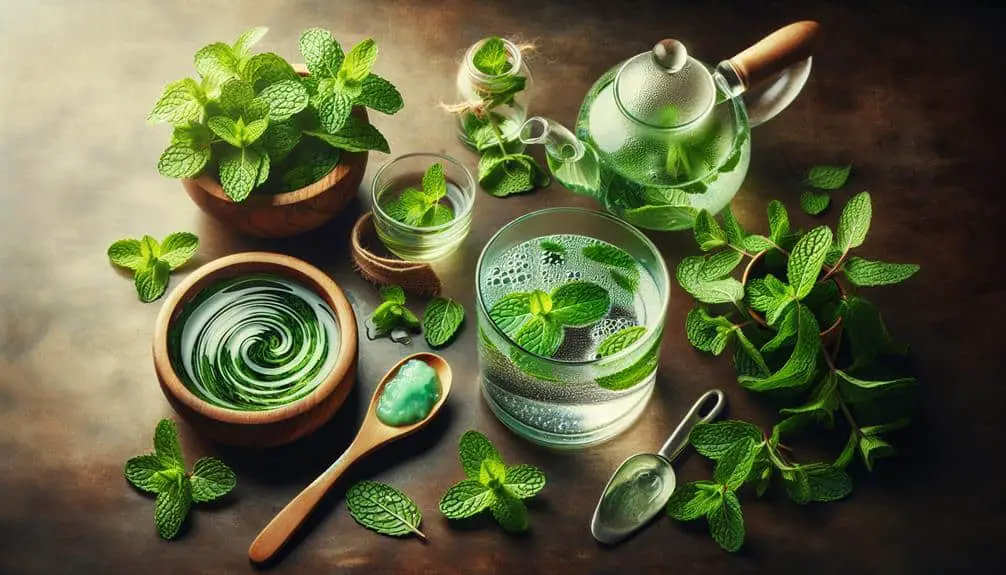Enhance your oral care routine with mint leaves by making a DIY whitening paste. Crush fresh mint leaves to create a natural teeth whitening treatment that brightens your smile and leaves a rejuvenating scent. Another option is to boil mint leaves in water to make a minty mouthwash, promoting oral health and freshening your breath. These DIY remedies are easy to make at home and offer natural benefits for your teeth and gums. More invigorating tips await for your oral care routine!
Key Points
- DIY whitening paste with fresh mint leaves for natural teeth whitening.
- Boil mint leaves to create a minty mouthwash with antibacterial properties.
- Crush mint leaves for a refreshing oral hygiene remedy.
- Mint leaves combat harmful bacteria, supporting gum health.
- Enjoy the invigorating flavor of mint leaves while maintaining good oral hygiene.
Benefits of Mint Leaves for Teeth
Enhance your oral health by incorporating mint leaves into your dental care routine. Mint leaf gum health is an important aspect of overall oral hygiene, and mint leaves can play a significant role in maintaining it. Mint leaves possess natural antibacterial properties that can help combat harmful bacteria in your mouth, reducing the risk of gum disease and promoting healthy gums.
By chewing on fresh mint leaves or using mint-infused mouthwash, you can support your gum health and prevent issues such as gingivitis.
Moreover, mint leaves are excellent for mint leaf oral hygiene. Their fresh and invigorating flavor can leave your mouth feeling clean and refreshed, masking bad breath effectively. Incorporating mint leaves into your daily oral care regimen can help you maintain good oral hygiene while enjoying the natural benefits of this herb.
Consider adding mint leaves to your diet or using mint-based toothpaste to experience the advantages they offer for your teeth and gums.
DIY Mint Leaf Teeth Whitening Paste
To create your own DIY mint leaf teeth whitening paste, gather fresh mint leaves and a few additional simple ingredients. Mint leaves contain natural whitening properties that can help brighten your smile while leaving a revitalizing minty freshness in your mouth.
Here's how you can make this paste at home:
Start by washing a handful of fresh mint leaves thoroughly. Next, finely chop or crush the mint leaves to release their juices. Then, mix the crushed mint leaves with a small amount of baking soda and a dash of water to form a paste-like consistency.
Once your paste is ready, use a clean toothbrush to apply it to your teeth. Gently brush your teeth with the mint leaf paste for about two minutes, focusing on areas where you want to see whitening results. After brushing, rinse your mouth thoroughly.
Repeat this process once or twice a week for natural whitening benefits and that delightful minty freshness.
Mint Leaf Mouthwash for Whitening
For an energizing way to enhance your oral care routine and continue benefiting from mint's whitening properties, consider making your own mint leaf mouthwash. This natural mouthwash can be a great addition to your daily oral health regimen. Mint leaves are known for their invigorating scent and antibacterial properties, making them an excellent choice for oral care.
To create your mint leaf mouthwash, start by boiling water and adding a handful of fresh mint leaves. Let it simmer for a few minutes before removing it from the heat. Allow the mixture to cool before straining out the leaves. Once cooled, you can use this mint-infused water as a natural mouthwash.
Using natural ingredients like mint leaves in your mouthwash can be a gentle yet effective way to promote oral health. The antibacterial properties of mint can help freshen your breath and contribute to a healthier mouth overall. Try incorporating this mint leaf mouthwash into your daily routine for an invigorating and natural approach to oral care.
Frequently Asked Questions
Can Mint Leaves Be Used to Treat Bad Breath?
Yes, mint leaves are effective in treating bad breath. Mint tea and mint oil are popular remedies. Simply brew mint tea or mix a drop of mint oil in water to freshen breath naturally.
Are There Any Potential Side Effects of Using Mint Leaves for Oral Health?
Using mint leaves for oral health may lead to potential side effects for individuals with mint allergies. Be cautious when consuming mint leaf tea. Always consult a healthcare provider before incorporating new remedies into your routine.
How Long Does a Mint Leaf Mouthwash Typically Last Before Needing to Be Replaced?
Typically, a mint leaf mouthwash can last for about a week before needing replacement. The effectiveness of the mouthwash may decrease after this time, impacting the benefits the mint leaves provide. Remember to check the shelf life!
Can Mint Leaves Help With Gum Inflammation or Sensitivity?
To address gum inflammation or sensitivity, mint leaf tea and mint leaf oil can be beneficial. Mint leaf tea can be soothing when sipped warm, while mint leaf oil can be diluted and used as a gentle mouth rinse.
Are There Any Specific Types of Mint Leaves That Are Better for Oral Health Remedies?
When it comes to oral health remedies, some mint leaf varieties stand out. The peppermint and spearmint varieties are known for their soothing properties. Try incorporating these into mint leaf tea for a invigorating and beneficial twist.




